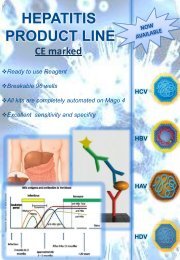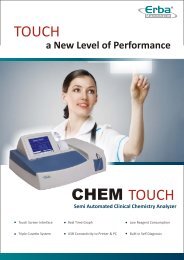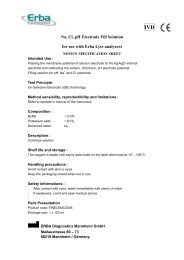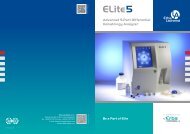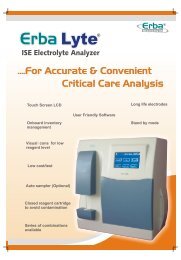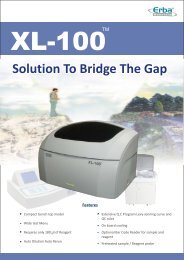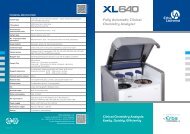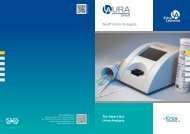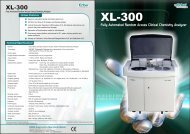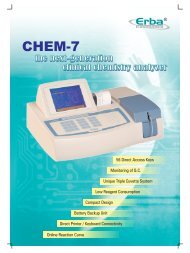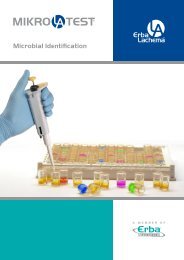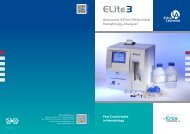TriPHAN - Erba Lachema sro
TriPHAN - Erba Lachema sro
TriPHAN - Erba Lachema sro
Create successful ePaper yourself
Turn your PDF publications into a flip-book with our unique Google optimized e-Paper software.
Diagnostic test strips for urine analysis<br />
Product webpage<br />
Test Strips<br />
for Urine Analysis<br />
1. Use only fresh, well-stirred urine. 2. Take out the strip from the tube. 3. Close the tube carefully,<br />
the desiccant protects<br />
the strips against air moisture.<br />
4. Dip the strip briefly (2-3 seconds)<br />
into the examined urine.<br />
5. Take out the strip and remove<br />
the excess urine from the strip.<br />
Wipe the rim of the strip on the<br />
container and cellulose cotton<br />
woole (do not wipe the test area).<br />
6. After the indicated reaction time<br />
has elapsed (see instructions)<br />
compare the colour of the test area<br />
with colour chart on the label.<br />
CAUTION<br />
• Keep the diagnostic strips in their original vials only, always well recapped.<br />
• Keep the vials with strips in a dry and dark place at the temperature<br />
+2 to +30 °C (not in refrigerator).<br />
• Protect the strips from moisture, direct sunlight,<br />
high temperature and chemical fumes (vapours).<br />
• Remove only enough strips for immediate use during testing<br />
and close the tube immediately and carefully.<br />
• Do not touch the indication areas of the strip.<br />
• Do not remove desiccant.<br />
<strong>Erba</strong> <strong>Lachema</strong> s.r.o.<br />
Karásek 1d, 621 33 Brno, Czech Republic<br />
Tel.: +420 517 077 111, fax: +420 517 077 077<br />
E-mail: diagnostics@lachema.com<br />
www.erbalachema.com<br />
Contact info / map<br />
Quick Overview<br />
of Patient‘s Health<br />
PHAN1010005EN
Regent pad Abbreviation Units Time<br />
of<br />
evaluation<br />
after<br />
Diagnostic Test Strips PHAN ® for urine analysis<br />
Colour scale Principle of the test Sensitivity<br />
Specificity<br />
SI<br />
Conv.<br />
Ascorbic Acid<br />
Interference<br />
Other<br />
Diagnostic Test Strips PHAN®<br />
for urine analysis<br />
Haemoglobin<br />
Erytrocytes<br />
Ketone KETO mmol/l<br />
mg/dl<br />
Bilirubin<br />
Urobilinogen<br />
HEMO Ery/µl ca 60 s oxidation of<br />
chromogene by the<br />
organic hydroperoxide<br />
in the present of the<br />
haemoglobine<br />
ca 60 s<br />
sodium nitropruside<br />
in the alkaline buffer<br />
(Legal‘s test)<br />
BILI arb.u. ca 60 s reaction of the<br />
diazonium salt in the<br />
acidicsurroundings<br />
UBG<br />
µmol/l<br />
mg/dl<br />
ca 60 s<br />
reaction of the diazonium<br />
salt in the acidic<br />
surroundings<br />
5 Ery/µl specific for haemoglobin<br />
and myoglobin<br />
0,1 - 0,2<br />
mmol/l<br />
4,3 - 5,2<br />
µmol/l<br />
6,0 µmol/l<br />
1,0 - 2,0 mg/dl high for acetoacetic acid,<br />
low for aceton, none for<br />
butyric acid<br />
0,25 - 0,30 mg/dl specific for conjugated<br />
bilirubin<br />
0,35 mg/dl<br />
urobilinogen and<br />
sterkobilinogen<br />
extremely high SG<br />
drugs and diagnostics on the bases of<br />
phenolphtalein or sulphophtalein<br />
high concentration of UBG and light<br />
phenazopiridine, bilirubin and light<br />
GlukoPHAN<br />
HemoPHAN<br />
KetoPHAN<br />
AlbuPHAN<br />
pck<br />
50<br />
50<br />
50<br />
50<br />
LEU<br />
NITRI<br />
pH<br />
PRO<br />
• •<br />
GLU<br />
UBG<br />
•<br />
BILI<br />
KETO<br />
HEMO<br />
•<br />
ASCO<br />
•<br />
SG<br />
MICROALB<br />
CREA<br />
Glucose<br />
Protein<br />
pH<br />
GLU<br />
PRO<br />
pH<br />
mmol/l<br />
g/l<br />
mg/dl<br />
ca 60 s<br />
ca 60 s<br />
ca 60 s<br />
enzymatic reaction<br />
- glucosoxidase,<br />
peroxidase, chromogene<br />
protein error of pH<br />
indicator - mixed<br />
acidobazic indicator<br />
changes the colour in the<br />
present of proteins<br />
the mixed acidobazic<br />
indicator<br />
0,9 mmol/l<br />
0,15 g/l<br />
16 mg/dl<br />
15 mg/dl<br />
specific for D-glucose<br />
specific for albumin<br />
Nitrites NITRI ca 60 s modified Griess‘ reaction 11 mmol/l 0,05 mg/dl specific for nitrite<br />
(70% of bacteriuria)<br />
All pads are protected<br />
against common<br />
concentrations<br />
of ascorbic acid.<br />
traces of detergens on the bases of peroxides<br />
and oxidazing agens<br />
drugs on the bases of quinine and quinoline,<br />
alkaline urine with pH > 8, traces of<br />
detergens and disinfectans on the bases of<br />
quarternaryammonium salt and urine with the<br />
high buffer capacity<br />
foreign substances on the alkaline and/or acidic<br />
bases, old urine with pH about 9<br />
diuresis and phenazopyridine<br />
DiaPHAN<br />
IktaPHAN<br />
<strong>TriPHAN</strong><br />
TetraPHAN Dia<br />
NefroPHAN<br />
leuco<br />
50<br />
50<br />
50/100<br />
50<br />
50<br />
• • •<br />
• •<br />
• •<br />
• • •<br />
• • • •<br />
•<br />
•<br />
Ascorbic Acid ASCO mmol/l ca 60 s reduction of<br />
mg/dl<br />
molybdophosphoric acid<br />
into molybdenum blue<br />
Specific Gravity SG ca 60 s the colour change of<br />
acidbase indicator depend<br />
on ion exchange<br />
Leukocytes LEU Leu/µl ca 120 s enzymatic reaction -<br />
esterase splits substrate<br />
into free indoxyl, which<br />
reacts with diazonium salt<br />
Mikroalbumine MICROALB g/l ca 60 s acidobasic indicator<br />
mg/l<br />
changes the colour in the<br />
present of albumine<br />
0,2 - 0,3<br />
mmol/l<br />
3.0 - 5,0 mg/dl non specific oxidationreduction<br />
reaction<br />
10 Leu/µl granulocytes<br />
and histiocytes<br />
0,03 g/l 30 mg/l specific for albumine<br />
reducing agens present in the urine<br />
pH > 6,5<br />
alkaline pH, higher SG and high concentration<br />
of bilirubin increases the intensity of colour<br />
reaction<br />
drugs on the bases of quinine and quinoline,<br />
alkaline urine with pH > 8, traces of<br />
detergens and disinfectans on the bases of<br />
quarternaryammonium salt and urine with the<br />
high and urine with a high buffer capacity, high<br />
concentration of creatinine (>26.5 mmol/l)<br />
PentaPHAN<br />
HexaPHAN<br />
HeptaPHAN<br />
NonaPHAN SG<br />
DekaPHAN<br />
leuco<br />
UndekaPHAN<br />
Microalbu PHAN<br />
50<br />
50/100<br />
50/100<br />
50<br />
50/100<br />
50<br />
50<br />
• • •<br />
• •<br />
• • • • • •<br />
• • • • • • •<br />
• • • • • • • • •<br />
• • • • • • • • • •<br />
• • • • • • • • • • •<br />
• •<br />
Creatinine CREA mmol/l ca 60 s Benedict-Behres‘ reaction 0,4 mmol/l 0,04 g/l specific for creatinine<br />
g/l<br />
urine with high buffer capacity decrease<br />
intensity of colour, high concentration<br />
of acetoacetic acid (>50 mmol/l)



